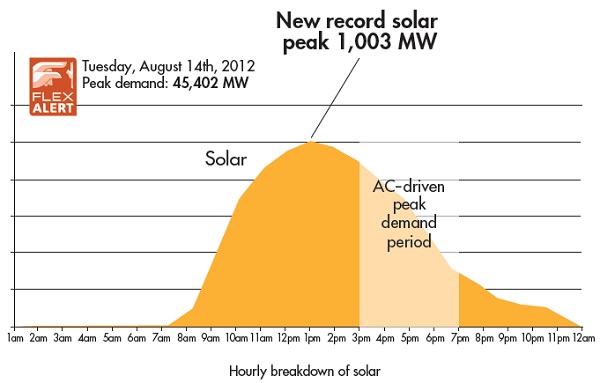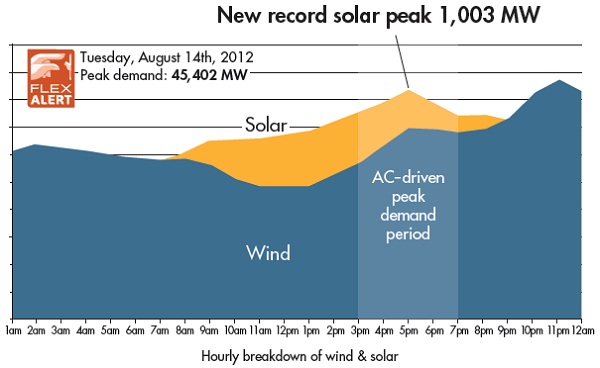The California Independent System Operator, which runs the state’s grid, has released a revised graphic for the day the state reached a milestone 1 gigawatt in utility solar power production that clears up confusion about when solar’s contribution to the grid peaked that day.
An earlier graphic had left many media with the impression that solar peaked between 5 and 6 p.m. on Aug. 14, just as millions of Golden State residents were arriving home from work and firing up their air conditioners, popping frozen delectables into the microwave and tuning in Two and a Half Men reruns.

But as EarthTechling had reported, solar power production actually peaked at 1,003 megawatts around 1 p.m. that day – 12:59 p.m., to be precise, a California ISO representative confirmed to us in an interview this week.
This isn’t surprising: As a National Renewable Energy Laboratory fact sheet [PDF] states, “PV provides the most electricity during midday on sunny days, but none during the evenings or at night.”

Whether solar provides “none” during evenings could be a bit of a question of semantics – when exactly does “evening” start? Here’s what we know: during hot summer days, solar continues to contribute significant if declining energy to the grid up to the 5 p.m. hour. On Aug. 14, 5 p.m. output was 700 MW – 30 percent less than at the 1 p.m. peak, but still pretty hefty. An hour later, at 6 p.m., it was down to 495 MW and by 7 p.m. it was at 321 MW.
That suggests that solar isn’t quite the contributor to peak demand that it is made out to be when California ISO says, as Communications Director Stephanie McCorkle did to the Desert Sun recently, “The beauty of solar power is it comes when you need it the most. Right at that air-conditioning rush hour, typically we see the peak of solar.”
The ISO’s own graphic shows that wasn’t the case on Aug. 14 (and patterns are pretty consistent on hot summer days). But that doesn’t mean solar wasn’t helping take a bite out of peak demand, which inched to around 45 gigawatts at 3 p.m. and more or less stayed at that level until about 5:30. As we said, solar was still at 90 percent of its peak production at 3 p.m., and even at 5 p.m. was at around 70 percent.
So the takeaway here is that solar is a contributor to meeting peak demand, as California ISO says, but it’s not as perfectly aligned to demand as we all might wish. Which is why combining solar with energy storage is gaining favor – but that’s another story.